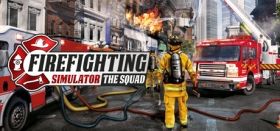
Firefighting Simulator gamescom Preview
If you look up the definition of surprise in the dictionary you’ll probably find a picture of me watching Firefighting Simulator at gamescom. Developed by Chronos and published by sim-kings Astragon, the game aims to place the player in a living, vibrant city and then task them with preventing it from burning down.
Built in the Unreal Engine 4, Firefighting Simulator features fully licenced vehicles from the firefighting departments of the US, and as a result has a wonderfully detailed fire truck as its centrepiece. While operating this mighty red wagon, the game will issue randomised calls to the player that will slowly increase in difficulty. These call-outs are incredibly in-depth, as the developers liaised with fire crews to get down the way they communicate. You’ll be told what type of material the building is made from, where the fire started, how many people they believe to be inside and whether or not other engines are on the scene and setting up secondary or tertiary water supplies.

You’re the hero in this tale though – it’s up to your yellow-garbed fireman to break down doors, extinguish flames and guide survivors to safety. AI engines and crews will play a support role as you explore the burning buildings. I was told by Astragon that the victim recovery programming was something yet to be improved – it will eventually be built up to include carrying people and dragging them to safety. Your main weapons against the flames are your fireman’s hose and your trusty axe – the former for extinguishing fire as you encounter it and the latter for smashing doors down and generally being a gas-mask wearing badass. Other AI engines will set up around your building and create new areas for your to attack the inferno – though focusing on one area can leave others weak and unprotected. As such, expect to be running through burning rooms to get to under-threat sections.
Your journey to emergencies through the city streets will be affected by both a day and a night cycle as well as adverse weather systems like dust storms. Both the fire and the smoke in the game has also been designed to mimic real-life scenarios and will change depending on environment, burning material type and how well the player is tackling them. I was also told that the game has multiple hazard simulations like backdrafts and explosions to make sure that the player doesn’t go blinding rushing in.

Firefighting Simulator will also include a multiplayer mode for up to five people, allowing teams to tackle the largest blazes together. There will also be a built-in skills system and RPG-light experience for levelling up your character – they will become better at skills as they are used more frequently – think Skyrim.
Graphically the game is impressive in places, if a little rough around the edges in others. Street traffic and pedestrians have obviously taken a back seat to the main event of firefighting, though with the game still being in development this might be improved upon. I was told that the developers were keen to make the city feel as lived-in as possible to give the player a feeling of connection and foster a need to protect the people who live there. The fire is believable and feels very threatening when you encounter it – smoke billows from its tips and it can crawl inexorably along walls, floors and ceilings towards the player. At one point in the playthrough we thought it was extinguished only to find it creeping around both sides of the player characters, trapping him in a circle of fire.
You’d be forgiven for thinking that Firefighting Simulator was just another run-of-the-mill sim soon to be pumped out along the rest to sit neatly in a categorised German videogames store. Yet the game shows a remarkable amount of depth and ambition, and with a release date set for 2017, it could get better yet.









COMMENTS